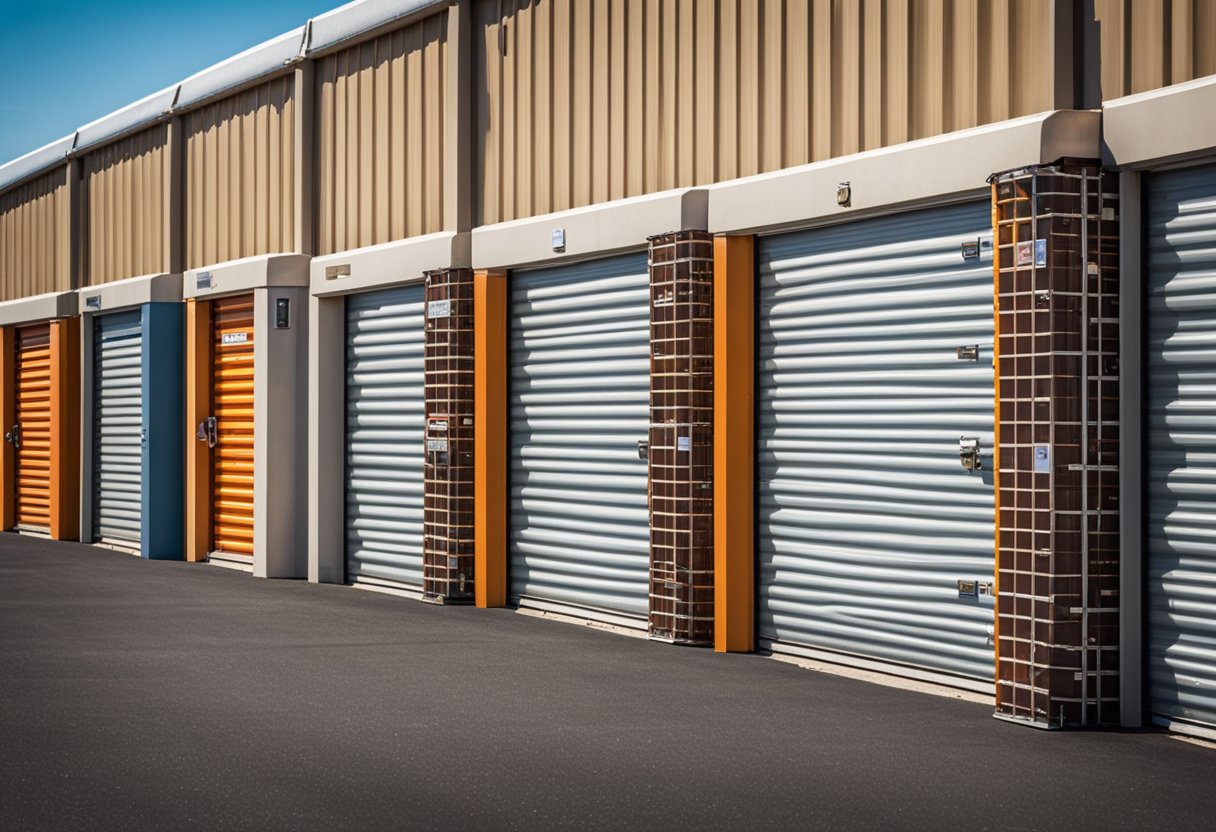Self-storage investing offers a unique opportunity in real estate with lower maintenance requirements compared to residential or commercial properties. You can expect operating expenses of around 35% of revenue when investing in self-storage facilities, making them potentially more profitable than other real estate investments.
Buying a self-storage facility means purchasing an existing income stream, where individual clients and businesses pay monthly rent for storage units. The steady cash flow and relatively simple business model make this investment strategy appealing for both new and experienced real estate investors.
Success in self-storage investing requires careful market analysis and evaluation of local competition. You’ll need to examine population growth, storage demand, and competitive pricing in your target area before making an investment decision.
Key Takeaways
- Self-storage facilities typically maintain steady cash flow with lower maintenance costs than traditional real estate
- Market analysis and location selection directly impact investment success rates
- Operating expenses average 35% of revenue, creating potential for strong profit margins
Understanding Self-Storage Investing
Self-storage investing offers a unique opportunity in commercial real estate with historically stable returns and lower maintenance requirements compared to other property types.
The Basics of Self-Storage Facilities
Self-storage facilities consist of individual units rented to tenants for storing personal belongings and business inventory. Unit sizes typically range from 5×5 feet to 10×30 feet.
The rental model operates on month-to-month leases, providing flexibility for both property owners and tenants. This structure allows for quick adjustments to market rates and easier tenant turnover.
Your primary revenue streams come from unit rentals, late fees, and the sale of packing supplies. Many facilities also offer climate-controlled units that command premium rates.
Self-Storage Real Estate as a Commercial Investment
You’ll find self-storage investment returns are often more resilient during economic downturns compared to other real estate sectors. Tenant diversification helps minimize risk, as no single tenant typically represents more than 1-2% of total revenue.
Operating costs tend to be lower than traditional commercial properties. You won’t need extensive staff or complex building systems to maintain the facility.
Market analysis is crucial for success. Examine local demographics, competition within a 3-5 mile radius, and population growth trends before investing.
Common value-add opportunities include implementing modern security systems, upgrading unit doors, and adding automated access controls to increase property appeal and rental rates.
Analyzing Market Trends
Market analysis reveals strong correlations between economic indicators and self-storage performance. Tracking these relationships helps investors make strategic decisions about property acquisitions and operations.
Impact of Interest Rates on Self-Storage Investing
Rising interest rates directly affect your borrowing costs for self-storage acquisitions. When rates increase, you’ll need higher property cash flows to maintain the same returns.
Cap rates tend to expand as interest rates climb, potentially creating buying opportunities in the self-storage sector. Your debt service coverage ratios become more critical during high-rate environments.
Properties with fixed-rate loans become more valuable during rate hikes. You can protect your investment by locking in longer-term fixed financing when rates are low.
Recession and the Self-Storage Sector
Self-storage has historically demonstrated resilience during economic downturns. The sector benefits from both downsizing households and businesses seeking cost-effective storage solutions.
Your occupancy rates may actually increase during recessions as people consolidate living spaces. Business customers often maintain storage units while reducing more expensive commercial space.
Rent collection typically remains stable since storage costs represent a small portion of household budgets. You’ll find that most tenants prioritize keeping their stored belongings safe.
Inflation and Storage Property Values
Rising consumer prices and wages positively impact self-storage income potential. Monthly rental rates can be adjusted quickly to keep pace with inflation.
Your property values benefit from increased construction costs during inflationary periods. New supply becomes more expensive to build, reducing competitive pressure on existing facilities.
Operating expenses like utilities and maintenance rise with inflation. You can offset these costs through regular rent increases while maintaining competitive rates.
Financial Considerations of Self-Storage Investing
Self-storage facilities offer unique financial dynamics with steady income potential and manageable operating costs. The key to success lies in maximizing revenue while maintaining efficient operations and strong cash flow management.
Revenue Generation in Self-Storage
Your rental income comes primarily from monthly tenant payments. Unit mix and pricing strategy directly impact your earning potential – smaller units often generate higher revenue per square foot.
Setting competitive rates requires analyzing local market dynamics and occupancy levels. Economic occupancy metrics matter more than physical occupancy.
Additional revenue streams include:
- Late fees and administrative charges
- Tenant insurance sales
- Moving supplies retail
- Climate-controlled unit premiums
- Vehicle/RV storage fees
Minimizing Financial Risk in Storage Investments
Self-storage investments offer lower risk compared to many other commercial properties due to diversified tenant bases and shorter lease terms.
Operating expenses typically remain predictable and manageable. The expense ratio averages around 35% of revenue.
Key risk reduction strategies:
- Thorough market analysis before purchasing
- Regular facility maintenance
- Strong security measures
- Professional management systems
- Emergency fund reserves
Understanding Cash Flow in Self-Storage Facilities
Monthly cash flow depends on occupancy rates, rental rates, and operating efficiency. Well-run facilities maintain consistent positive cash flow through economic cycles.
Track these essential metrics:
- Net Operating Income (NOI)
- Debt Service Coverage Ratio
- Collection rates
- Expense ratios
- Occupancy trends
Careful market examination and competitive analysis within your target radius helps ensure sustainable cash flow. Regular financial review and adjustments keep your facility performing optimally.
Operational Strategies for Self-Storage Facilities

Strategic pricing and consistent facility maintenance create the foundation for a profitable self-storage investment. Regular attention to core operational elements helps maximize your revenue potential and keeps renters satisfied.
Maintenance and Upkeep of Storage Facilities
Schedule weekly inspections of your doors, locks, and security systems to identify potential issues before they become costly problems. Clean units between tenants and maintain clear access paths.
Keep detailed maintenance logs to track repairs and schedule preventive work. This documentation helps control costs and demonstrates professional management to your tenants.
Install proper lighting throughout the facility and maintain surveillance systems. These security measures protect your investment and give renters peace of mind.
Regular pest control treatments and climate control system maintenance prevent damage to stored items. Check temperature and humidity levels in climate-controlled units daily.
Maximizing Occupancy Rates Among Renters
Implement dynamic pricing strategies based on unit size, location within the facility, and seasonal demand. Adjust rates monthly to stay competitive while maximizing revenue.
Create a strong online presence with detailed unit descriptions and photos. Make it easy for potential renters to reserve units through your website.
Offer move-in specials during slow seasons to attract new tenants. Consider providing referral bonuses to existing renters who bring in new customers.
Monitor your competition’s rates and amenities to ensure your facility remains attractive to potential renters. Maintain high visibility through local advertising and community involvement.
Investment Vehicles in Self-Storage
Self-storage investments offer multiple paths to generate recurring income, from hands-on property ownership to passive REIT investments that require minimal involvement.
Pros and Cons of Self-Storage REITs
Self-storage REITs provide instant diversification across multiple facilities and markets. You gain professional management expertise without dealing with day-to-day operations.
REITs offer high liquidity – you can buy or sell shares easily through standard brokerage accounts. Dividend yields typically range from 2.5% to 4.5% annually.
The main drawbacks include less control over property decisions and potentially lower returns compared to direct ownership. Market volatility can affect share prices significantly.
Direct Ownership vs. REITs in Self-Storage
Direct facility ownership gives you complete control over operations, pricing, and property improvements. Your potential returns are higher, often reaching 8-15% annually through both rental income and property appreciation.
You’ll need substantial capital – typically 25-35% down payment plus renovation costs. Direct ownership requires active management or hiring staff to handle daily operations.
The choice depends on your goals:
- Direct ownership: Higher returns, more control, requires hands-on management
- REITs: Lower barrier to entry, passive income, professional management
Private equity funds offer a middle ground, combining professional oversight with potentially higher returns than REITs.
Regional Considerations for Self-Storage Investing

Smart self-storage investments depend heavily on understanding local market dynamics and regulatory requirements. Demographics, economic indicators, and state laws significantly impact facility performance and investment returns.
Identifying Growth Areas for Storage Facilities
Population growth trends and median household income serve as key indicators for profitable self-storage investment opportunities. Target areas with at least 3-5% annual population growth and median incomes above $50,000.
Look for locations near apartment complexes, military bases, or universities where transient populations create steady demand. Multi-family housing developments within a 3-mile radius typically indicate strong storage needs.
Analyze competitors within a 5-mile radius. Ideal markets show occupancy rates above 85% at existing facilities while maintaining room for new development.
State-Specific Regulations: Texas as a Case Study
Texas provides an excellent environment for self-storage investments due to its business-friendly regulations and strong property rights laws. You must register your facility with the Texas Self Storage Association and comply with the Texas Property Code Chapter 59.
The state allows flexible lien enforcement procedures, enabling you to auction delinquent units after 30 days notice. Texas also permits value-limitation options for stored goods, reducing liability exposure.
Building permits in Texas typically process faster than other states, with many jurisdictions offering expedited reviews for storage developments. Local zoning laws vary by municipality, so research specific county requirements before purchasing land.
Building Long-Term Wealth Through Self-Storage
Self-storage investing offers a reliable path to building substantial net worth through steady cash flow and high profit potential. You can start by acquiring existing facilities or developing new ones from the ground up.
Your investment options include purchasing a pre-existing self-storage facility or constructing a new development. Both approaches can generate significant returns when executed properly.
The key advantage of self-storage as a real estate investment lies in its lower maintenance requirements compared to residential or commercial properties. You won’t deal with tenant improvements, complex lease agreements, or extensive property upkeep.
To maximize your returns, focus on:
- Strategic location selection
- Efficient facility management
- Competitive pricing
- Regular maintenance
- Marketing optimization
Self-storage investments generate income through monthly rental payments while potentially appreciating in value over time. Your revenue streams can include standard unit rentals, climate-controlled spaces, and additional services like moving supplies sales.
Professional analysis tools help you evaluate potential investments. Using specialized self-storage analyzers can provide detailed insights into property performance and potential returns before making investment decisions.
Frequently Asked Questions
Successful self-storage investing requires understanding market analysis, financial metrics, and investment vehicles while managing risks and costs effectively. New investors can enter the market through multiple pathways with varying capital requirements.
What are the first steps for beginners interested in investing in self-storage?
Start by researching specific markets and examining cash flow potential in your target area. Calculate potential revenue by analyzing local competition and occupancy rates.
Connect with experienced self-storage investors and operators to learn from their experiences. Join industry associations and attend relevant conferences.
Consider partnering with experienced investors or working with a mentor for your first deal.
What is the average return on investment for a self-storage facility?
Self-storage facilities typically generate cash-on-cash returns between 6-12% annually, with potential for higher returns through operational improvements.
Cap rates generally range from 5-8% in prime markets and can reach 9-11% in secondary markets.
Value-add opportunities through renovation and better management can increase returns significantly.
How do self-storage real estate investment trusts (REITs) compare to owning physical storage units?
REITs offer immediate liquidity and require less capital to start investing compared to direct ownership. You can buy and sell REIT shares quickly through standard brokerage accounts.
Direct ownership provides more control over operations and decisions but requires hands-on management or hiring property managers.
Both accredited and non-accredited investors can access various self-storage investment options.
What are the key factors to consider before investing in self-storage units?
Location demographics and population growth trends heavily influence facility performance. Analyze local household income levels and moving patterns.
Evaluate the facility’s current occupancy rates, rental rates, and potential for rate increases.
Review the property’s physical condition, security features, and needed upgrades.
What are the potential risks associated with self-storage investing?
Market saturation can lead to increased competition and lower rental rates. New construction in your area may impact occupancy levels.
Economic downturns might affect occupancy rates, though self-storage has historically shown resistance to recessions.
Property management challenges include dealing with delinquent tenants and maintenance issues.
How does the cost of building or buying self-storage units impact the investment decision?
Construction costs typically range from $25-$70 per square foot, depending on location and facility type. Land acquisition costs vary significantly by market.
Renovation of existing facilities often costs less than new construction but may require extensive upgrades to compete with modern facilities.
Financing terms and down payment requirements affect your initial capital needs and long-term returns.
Ever wish you could analyze properties like the pros?
Save time and make smarter investment decisions with the most powerful real estate analysis software on the market.
Enter the code BESTDEAL at check out and receive a 20% Off Discount!

Dive deep into the world of real estate investment with this comprehensive case study that brings theory to life.
Investment Real Estate Analysis: A Case Study offers an unparalleled look at the decision-making process behind successful property investments. Follow along as we dissect a real-world scenario, revealing the critical factors that seasoned investors consider before making a move.
From crunching numbers to assessing market conditions, this book walks you through every step of the analysis process. Learn how to evaluate potential investments like a pro, understanding key metrics such as cap rates, cash-on-cash returns, and internal rate of return.
Whether you’re a novice investor or looking to refine your skills, this case study will equip you with the tools to make informed investment decisions in the competitive real estate market.
Get your copy now from your favorite bookseller:
- Amazon
- Books2Read for Apple, Barnes & Noble, Kobo, Scribed, and 8 more sellers with both eBook and paperback options available
- Payhip as a downloadable PDF
Ready to take your business to the next level?
- Subscribe to our newsletter
- Visit the learning center
- Learn more about our consulting services
This blog post was created by J. Scott Digital content creation services.



